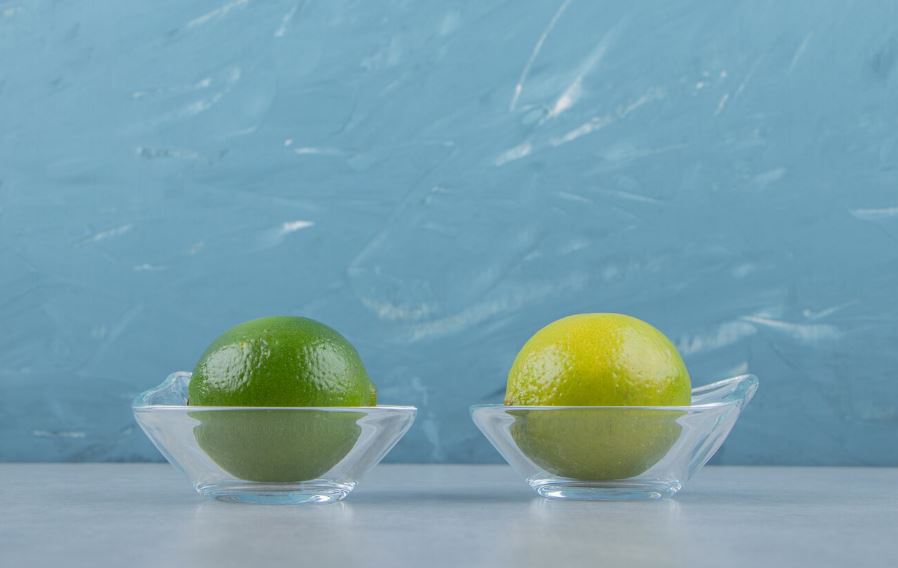
The decision between lemon and lime can seem surprisingly straightforward—yet remarkably complex—for anyone attempting to control their weight without turning to supplements or trendy goods. Although the macronutrient composition of these citrus cousins is almost the same, their ability to support hydration, appetite control, and metabolic balance can vary depending on when they are used, their subtle taste differences, and their micronutrient content.
Lemons are especially healthy when consumed early in the day because they contain a little more vitamin C and folate. Celebrities such as Gwyneth Paltrow have commended the benefits of a warm glass of lemon water, particularly before breakfast, for promoting hydration and gently stimulating digestion before calories are even consumed. Not only is this early hydration practice a wellness ritual, but it’s also a very powerful strategy to cut down on morning snacking and enhance portion control at your first meal.
| Factor | Lemon | Lime |
|---|---|---|
| Calories (per 100g) | 29 | 30 |
| Vitamin C Content | Higher (53 mg) | Lower (29.1 mg) |
| Taste Profile | Tangy with a hint of sweetness | Sharper and more bitter |
| Ideal Time of Use | Morning or pre-meal hydration | Afternoon refreshers or with meals |
| Nutrient Advantages | More folate, potassium | More vitamin A, calcium |
| Satiety and Appetite Control | Supports early-day fullness | Helps curb cravings during the day |
| Citric Acid Level | Slightly higher (1.44 g/oz) | Slightly lower (1.38 g/oz) |
| Popularity in Routines | Common in warm detox drinks | Used in tropical detox blends |
| Common Celebrity Usage | Beyoncé, Gwyneth Paltrow | Used in Latin-style wellness regimens |
On the other hand, limes, which are frequently bitter and sharper, tend to be more noticeable later in the day. Lime becomes a potent tool for afternoon hydration and flavor without adding sugar when it is mixed with mint and cucumber in chilled infusions or added to sparkling water. In addition to being cultural staples in places like Southeast Asia and Latin America, beverages with lime infusions also naturally aid in the comfort of the digestive system after larger meals. Because of this, they are very effective at reducing cravings in the late afternoon, when sweet temptations are most likely to occur.
Researchers studying nutrition have observed over the last ten years that citrus acids may marginally increase metabolism, especially when combined with physical activity. When paired with bread, lemon juice reduced the post-meal glycemic response more than plain water, according to a French study. That suggests that lemon may aid in blood sugar stabilization, which is important for people attempting to control their weight through a balanced insulin response, even though it doesn’t directly imply fat burning.
When dietary diversity is limited, limes are a good option because they have a slight advantage in calcium and vitamin A. They have the potential to improve mineral absorption when eaten with meals high in protein, such as fish, even though their acidity is only marginally lower than that of lemon. Lime water, which emphasizes its refreshing tang over sweetness, is frequently used to naturally replenish electrolytes in warm climates.
Another important indicator of lifestyle alignment is the timing of use. Lemons are kinder and go better with warm teas or herbal brews during morning routines. In order to feel lighter and more energized before rehearsals, Beyoncé, for example, makes drinking warm lemon water a daily ritual. Limes, on the other hand, are frequently used in smoothies after yoga or the gym because of their tartness, which perfectly balances protein powders and greens and meets your midday energy needs.
Both fruits provide almost the same amount of fiber per 100 grams when considering satiety. The true advantage, however, comes from water volume because we usually only eat a slice or two at a time. Stretch receptors in the stomach use a tall glass of water with citrus flavoring, such as lemon or lime, to indicate fullness. When this feeling is regularly experienced throughout the day, it promotes mindful meal spacing and reduces needless snacking.
Citrus water has become a habitual tool for people who are interested in intermittent fasting or intuitive eating. The “Lemon in the AM, Lime in the PM” strategy is now promoted by a number of clean-eating communities on social media sites like Instagram and TikTok. Not only is it catchy, but it also illustrates how to use each fruit at its most useful time. Lemons for peaceful, balancing morning rituals. Limes for quick metabolic restarts as afternoon hunger swings occur.
From a culinary perspective, because of their slightly sweeter acidity, lemons are frequently used in marinades, roasted vegetables, and dressings. Because of their strong flavor, limes go well with tropical or spicy dishes. This disparity has encouraged chefs and nutritionists to strategically use each fruit, not only to add flavor to food but also to change eating habits to include more fiber-rich, lighter meals that promote weight loss.
The larger context of health must also be taken into account. Antioxidants and flavonoids, which are abundant in lemons and limes, help to lower inflammation, which is associated with easier fat metabolism. Additionally, they promote the production of collagen, which keeps skin supple when weight fluctuates. These indirect advantages, which are sometimes disregarded, support a weight-loss plan’s long-term viability.
Due to its acidity, consuming too much of either juice, particularly in concentrated form, can harm tooth enamel. Nevertheless, this risk is greatly decreased when used sparingly and through a straw. Staying hydrated is made easier by including lemon or lime in your daily water routine, which is not only safe but also much more enticing than plain water.
In light of current social trends, citrus drinks have come to represent healthy living. A common digital wellness practice among influencers, stylists, and athletes alike is the simple practice of squeezing a wedge into water. Its popularity signifies a trend toward actions that seem affordable, empowering, and easily accessible.
In the end, the “lemon vs. lime” debate over weight loss isn’t clear-cut; rather, it depends on the season, the circumstance, and the individual. Lemon is especially beneficial during the slower, grounding portions of the day when hydration and calm digestion are essential. With its energizing bitterness, lime is best saved for hot weather or active afternoons where energy and appetite need to be better managed.
